
A steam locomotive is a locomotive that provides the force to move itself and other vehicles by means of the expansion of steam. It is fuelled by burning combustible material to heat water in the locomotive's boiler to the point where it becomes gaseous and its volume increases 1,700 times. Functionally, it is a steam engine on wheels.

A geared steam locomotive is a type of steam locomotive which uses gearing, usually reduction gearing, in the drivetrain, as opposed to the common directly driven design.
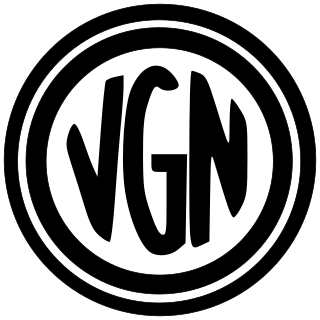
The Virginian Railway was a Class I railroad located in Virginia and West Virginia in the United States. The VGN was created to transport high quality "smokeless" bituminous coal from southern West Virginia to port at Hampton Roads.
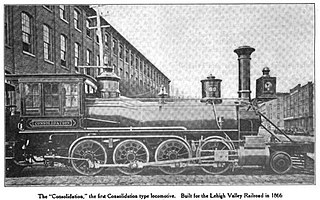
Under the Whyte notation for the classification of steam locomotives, 2-8-0 represents the wheel arrangement of two leading wheels on one axle, usually in a leading truck, eight powered and coupled driving wheels on four axles, and no trailing wheels. In the United States and elsewhere, this wheel arrangement is commonly known as a Consolidation, after the Lehigh and Mahanoy Railroad’s Consolidation, the name of the first 2-8-0.

The Norfolk and Western Railway, commonly called the N&W, was a US class I railroad, formed by more than 200 railroad mergers between 1838 and 1982. It was headquartered in Roanoke, Virginia, for most of its existence. Its motto was "Precision Transportation"; it had a variety of nicknames, including "King Coal" and "British Railway of America". In 1986, N&W merged with Southern Railway to form today’s Norfolk Southern Railway.
A 2-8-8-2, in the Whyte notation for describing steam locomotive wheel arrangements, is an articulated locomotive with a two-wheel leading truck, two sets of eight driving wheels, and a two-wheel trailing truck. The equivalent UIC classification is, refined to Mallet locomotives, (1'D)D1'. These locomotives usually employ the Mallet principles of articulation—with the rear engine rigidly attached to the boiler and the front engine free to rotate—and compounding. The 2-8-8-2 was a design largely limited to American locomotive builders. The last 2-8-8-2 was retired in 1962 from the N&W's roster, two years past the ending of steam though steam was still used on steel mill lines and other railroads until 1983.
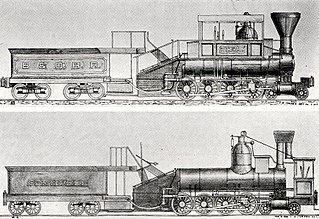
Under the Whyte notation for the classification of steam locomotives, 4-8-0 represents the wheel arrangement of four leading wheels on two axles, usually in a leading truck or bogie, eight powered and coupled driving wheels on four axles and no trailing wheels. In North America and in some other countries the type was usually known as the Twelve-wheeler.

The Roanoke Shops is a Norfolk Southern workshop and maintenance facility in Roanoke, Virginia. Between 1884 and 1953, the shops produced 447 steam locomotives, all for the Norfolk & Western Railway (N&W). The Roanoke Locomotive Shops famous known steam locomotives preserved were Norfolk and Western 611, a N&W Class J 4-8-4 "Northern" built in 1950, Norfolk and Western 1218, an articulated N&W Class A 2-6-6-4 built in 1943, and Norfolk and Western 2156, an articulated Class Y6A 2-8-8-2 built in 1942.
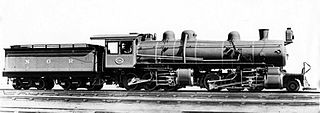
Under the Whyte notation for the classification of steam locomotives by wheel arrangement, 2-6-6-0 is a locomotive with one pair of unpowered leading wheels, followed by two sets of three pairs of powered driving wheels and no trailing wheels. The wheel arrangement was principally used on Mallet-type articulated locomotives. Some tank locomotive examples were also built, for which various suffixes to indicate the type of tank would be added to the wheel arrangement, for example 2-6-6-0T for an engine with side-tanks.

The London and North Eastern Railway LNER Gresley Classes A1 and A3 locomotives represented two distinct stages in the history of the British 4-6-2 "Pacific" steam locomotives designed by Nigel Gresley. They were designed for main line passenger services and later express passenger services, initially on the Great Northern Railway (GNR), a constituent company of the London and North Eastern Railway after the amalgamation of 1923, for which they became a standard design. The change in class designation to A3 reflected the fitting to the same chassis of a higher pressure boiler with a greater superheating surface and a small reduction in cylinder diameter, leading to an increase in locomotive weight. Eventually all of the A1 locomotives were rebuilt, most to A3 specifications, but no. 4470 was completely rebuilt as Class A1/1.

Under the Whyte notation for the classification of steam locomotives, 2-6-0+0-6-2 represents the wheel arrangement of an articulated locomotive with two separate swivelling engine units, arranged back to back with the boiler and cab suspended between them. Each engine unit has two leading wheels in a leading truck, six powered and coupled driving wheels on three axles and no trailing wheels.

The Powhatan Arrow was one of the named passenger trains of the Norfolk and Western. Its route ran from Norfolk, Virginia, to Cincinnati, Ohio.

The Norfolk and Western class J was a class of fourteen 4-8-4 "Northern" streamlined steam locomotives built by the Norfolk and Western Railway (N&W) at its Roanoke Shops in Roanoke, Virginia, from 1941 to 1950. They were operated in revenue service until the late 1950s.

The Virginia Museum of Transportation is a museum devoted to the topic of transportation located in Downtown Roanoke, Virginia, US.

Strasburg Rail Road 475 is a 4-8-0 "Mastodon" type steam locomotive built by the Baldwin Locomotive Works in June 1906 as part of the Norfolk and Western Railway's (N&W) first order of M class numbered 375–499. It was first assigned to haul freight trains on the N&W mainline before being reassigned to branch line duties on the Blacksburg Branch in the 1920s. Retired from revenue service in 1957, No. 475 was sold to various different owners in Pennsylvania, Illinois, and Iowa until 1991 when it was purchased and restored by the Strasburg Rail Road (SRC) in Strasburg, Pennsylvania, where it currently runs tourist excursion trains in the Pennsylvania Dutch countryside. Since then, No. 475 became the only 4-8-0 locomotive operating in North America and the oldest operating steam locomotive on the SRC.
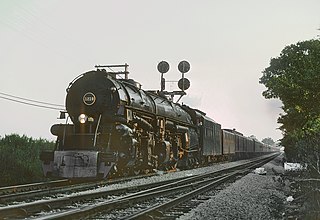
Norfolk and Western 1218 is a preserved four-cylinder simple articulated 2-6-6-4 steam locomotive, built in June 1943 by the Norfolk and Western's (N&W) East End Shops in Roanoke, Virginia as part of the N&W's class "A" fleet of fast freight locomotives. It was retired from regular revenue service in July 1959, and was later restored by Norfolk Southern for excursion service for their steam program, pulling excursions throughout the eastern United States from 1987 to 1991. It is currently on static display at the Virginia Museum of Transportation in Roanoke, Virginia.

Norfolk & Western 2156 is a four-cylinder compound articulated class "Y6a" "Mallet" type steam locomotive with a 2-8-8-2 wheel arrangement. The Norfolk & Western Railway built it in 1942 at its Roanoke Shops in Roanoke, Virginia as a member of the N&W's Y6a class. It is the strongest-pulling extant steam locomotive in the world, although it is not operational. It was retired from regular rail service in July 1959 and is now owned by the National Museum of Transportation in St. Louis, Missouri.
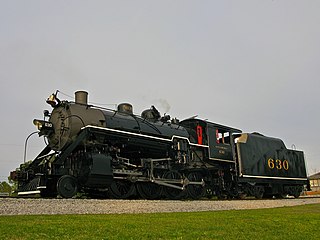
Southern Railway 630 is a 2-8-0 "Consolidation" type steam locomotive built in February 1904 by the American Locomotive Company (ALCO) of Richmond, Virginia for the Southern Railway as a member of the Ks-1 class. It is currently owned and operated by the Tennessee Valley Railroad Museum (TVRM) in Chattanooga, Tennessee where it resides today for use on excursion trains.

Norfolk and Western 611, also known as the "Spirit of Roanoke" and the "Queen of Steam", is a Norfolk and Western (N&W) class J 4-8-4 "Northern" streamlined steam locomotive built in May 1950 by the N&W's East End Shops in Roanoke, Virginia. It was one of the last mainline passenger steam locomotives built in the United States and represents the pinnacle of steam locomotive technology.

Norfolk and Western 433 is a preserved class M 4-8-0 "Mastodon" type steam locomotive built by the American Locomotive Company's Richmond Locomotive Works in January 1907 for the Norfolk and Western Railway. It was one of 125 M Class engines in operation on the N&W for around 50 years. After surviving an accident in 1951, the 433 was rebuilt and worked in Bristol, Virginia for a time where she was also assigned as a back up locomotive for the Abingdon Branch. This "Mollie" also worked as a switcher in Roanoke, Salem, and Radford. The 433 was eventually retired in 1958 and it became one of only two M Class locomotives to survive aside from the "Lost Engines of Roanoke". It was cosmetically restored in 2002 and now resides as a static display along the old Virginia Creeper Trail in Abingdon.



















